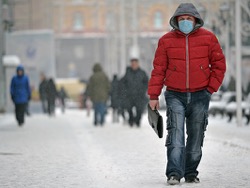Viruses-cyanophage prohibit cyanobacteria absorb carbon dioxide.
It is believed that when oxygen appeared on Earth by marine cyanobacteria – a long time ago they learned the photosynthesis and began using sunlight to store energy and to spend it for the synthesis of carbohydrates from carbon dioxide, instead of releasing O<sub>2</sub>.

Cyanobacteria of the genus Synechococcus. (Photo yundaga / www.flickr.com/photos/98524386@N00/6939312881.)
“”
Now, cyanobacteria and other microscopic photosynthetics living in the oceans, “eat” half of the total CO<sub>2</sub> from the atmosphere, since carbon dioxide is one of the main greenhouse gases, the role of oceanic microbes in the formation of the earth’s climate cannot be overstated.
However, cyanobacteria, like all bacteria, often become victims of viruses cyanophages. Viruses entering the cell, use its resources for their own reproduction, in order to create as many new viral particles.It can be assumed that the virus inside cyanobacteria is not photosynthesis.
Researchers from the University of Warwick decided to learn how viral infection affects the photosynthetic ability of cyanobacteria Synechococcus is one of the many microbes-photosynthetic organisms. David Scanlan (David J. Scanlan) and his colleagues added to the culture of Synechococcus of cyanophages caught (more precisely, allocated) of the water of the red sea and English channel.
As a source of co<sub>2</sub> for the bacteria used sodium bicarbonate, which is easily decomposed with formation of carbon dioxide; the carbon in the bicarbonate was radioactive in order to monitor the uptake of CO<sub>2</sub> by cyanobacteria.
In an article in Current Biology , the authors write that after just a few hours after infection, the fixation of carbon dioxide into the bacterial culture was slowed down: those of Synechococcus, which went cyanophages from the red sea, absorb CO<sub>2</sub> 4.8 times slower, and those who got cyanophage of the channel is 2.3 times slower compared to “healthy” cells.
The virus disabled not the photosynthesis, but only its later stages. As is well known, the photosynthetic reactions are divided into two phases: the first, or light, the energy of sunlight is captured by special protein complexes and stored in the form of energy molecules ATP (and then oxygen is produced); on the second, or temnova, step is the transformation of carbon dioxide into glucose that gets stored in the form of ATP energy.
Viruses disable it the stage of fixing CO<sub>2</sub>, which is understandable – they are dependent on intracellular energy supplies and therefore try to keep them for themselves, for their own reproduction.
How much this cyanophage can affect the dynamics of carbon dioxide? Researchers estimate that because of the viruses in the atmosphere can remain unabsorbed from 20 million to 5.39 billion tons of carbon, where the upper figure (of 5.39 billion tonnes) is 10% of the carbon that is fixed (i.e. converted into digestible carbohydrates) to the oceans, and 5% of all of the carbon fixed all the ecosystems of the Earth.
Perhaps the greenhouse effect could severely weaken, if we have helped cyanobacteria to get rid of their cyanophages. But in order to accurately determine the extent of sabotage viruses and to understand whether or not to free them from bacteria, you need to first know how the bacteria suffer from them. And then the spread of numbers is very high: according to various estimates, the proportion of infected cyanobacteria ranged from 1% to 60%.
On the other hand, the above experiments were made under laboratory conditions. In the ocean, in conditions of natural ecosystems with a variety of other cyanobacteria and other cyanophages, the situation with viral effect on the fixation of carbon dioxide may look different.
On materials Science.
Author: Cyril Stasevich
Source: nkj.EN







